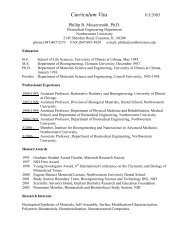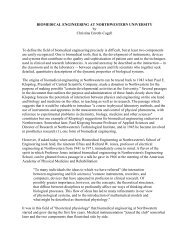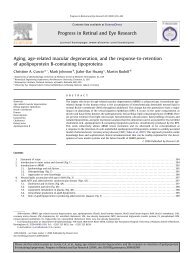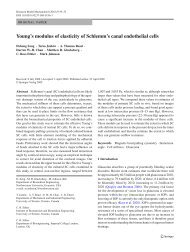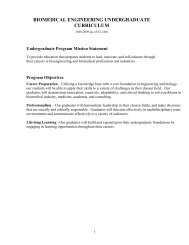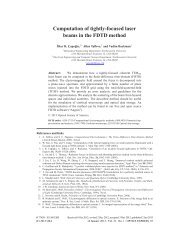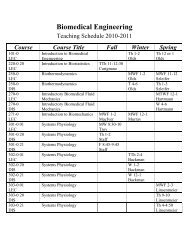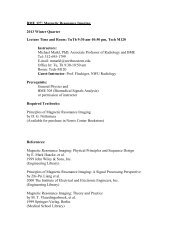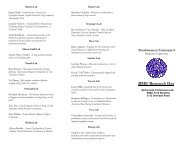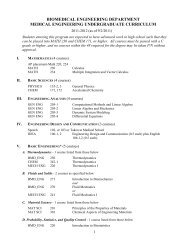antifouling polymers - BIMat :: Biologically Inspired Materials
antifouling polymers - BIMat :: Biologically Inspired Materials
antifouling polymers - BIMat :: Biologically Inspired Materials
You also want an ePaper? Increase the reach of your titles
YUMPU automatically turns print PDFs into web optimized ePapers that Google loves.
Bioinspired<br />
<strong>antifouling</strong> <strong>polymers</strong><br />
by Jeffrey L. Dalsin and Phillip B. Messersmith*<br />
Controlling biointerfacial phenomena is crucial to the<br />
success of many biomedical technologies. For<br />
applications in biosensing, diagnostics, and medical<br />
devices, precise control of interactions between<br />
material surfaces and the biological milieu is an<br />
important but elusive goal 1 . Emerging strategies for<br />
manipulating the biological response to medical<br />
materials seek to take advantage of specific<br />
interactions between designed surfaces, biomolecules,<br />
and cells 2 . Limiting nonspecific interaction of cells,<br />
proteins, and microorganisms with material surfaces<br />
is critical, since these interactions can prove highly<br />
problematic for device efficacy and safety. Thus, a<br />
central research focus continues to be the<br />
development of versatile, convenient, and costeffective<br />
strategies for rendering surfaces resistant to<br />
fouling by proteins, cells, and bacteria.<br />
Biomedical Engineering Department,<br />
Northwestern University,<br />
2145 Sheridan Road,<br />
Evanston, IL 60208, USA<br />
*E-mail: philm@northwestern.edu<br />
A common method to reduce cellular and<br />
proteinaceous fouling is the immobilization of<br />
<strong>antifouling</strong> <strong>polymers</strong> on biomaterial surfaces (Fig. 1).<br />
Several polymer classes have been explored for this<br />
purpose, including polyacrylates 3-7 ,<br />
oligosaccharides 8,9 , polymer mimics of<br />
phospholipids 10-12 , and poly(ethylene glycol)<br />
(PEG) 13-17 . Although the general physical and<br />
chemical properties that make surfaces <strong>antifouling</strong><br />
are not known, Merrill 18 as well as Whitesides and<br />
coworkers 19 postulate that nonfouling surfaces<br />
should be electrically neutral, hydrophilic, and<br />
possess hydrogen bond acceptors but not hydrogen<br />
bond donors. Although exceptions to these rules have<br />
been observed 20,21 , many <strong>polymers</strong> with <strong>antifouling</strong><br />
properties possess most of these traits.<br />
Two basic strategies exist for functionalizing material<br />
surfaces with <strong>antifouling</strong> <strong>polymers</strong>. The first approach,<br />
termed graft-to, consists of the adsorption to surfaces of<br />
presynthesized polymer chains end-functionalized with a<br />
chemical anchoring group (Fig. 1, top). Alternatively,<br />
graft-from approaches, in which a polymer is grown in situ<br />
from the surface via a surface-adsorbed initiation group, are<br />
generally capable of producing denser polymer layers (Fig. 1,<br />
bottom). Essential to both approaches, however, is the<br />
requirement of a robust mechanism for immobilizing the<br />
<strong>antifouling</strong> polymer onto metals, ceramics, <strong>polymers</strong>, and<br />
electronic materials. Numerous methods of anchoring<br />
<strong>polymers</strong> to surfaces have been proposed, and can be broadly<br />
classified as either physisorptive or chemisorptive.<br />
38 September 2005<br />
ISSN:1369 7021 © Elsevier Ltd 2005
REVIEW FEATURE<br />
Fig. 1 ‘Graft-to’ (top) and ‘graft-from’ (bottom) strategies for modification of surfaces<br />
with <strong>antifouling</strong> <strong>polymers</strong>.<br />
Physisorption relies on relatively weak van der Waals and<br />
hydrophobic forces to tether <strong>polymers</strong> to a surface.<br />
Consequently, the <strong>polymers</strong> are not irreversibly bound to the<br />
surface and proteins may be exchanged with the polymer on<br />
the surface 22 . To provide greater stability, anchoring<br />
strategies involving the formation of more robust chemical<br />
bonds between the polymer and surface are deemed more<br />
desirable, as exemplified by thiol-Au 23,24 or silane-metal<br />
oxide interactions 25 . Most existing chemisorptive approaches<br />
for polymer immobilization, however, suffer from significant<br />
limitations, such as substrate chemical specificity,<br />
complicated and expensive protocols, and susceptibility to<br />
thermal or hydrolytic degradation 26,27 .<br />
A versatile, simple, and cost-effective method for<br />
functionalization of surfaces, therefore, would be of great<br />
value in designing <strong>antifouling</strong> biointerfaces, as well as more<br />
generally in the context of surface modification of materials.<br />
In this article, we review new experimental strategies that we<br />
have developed to exploit the natural adhesive characteristics<br />
of ‘bio-glues’ from one of nature’s most notorious fouling<br />
organisms, the mussel. Mimics of mussel adhesive proteins<br />
are used in the form of chemical conjugates with <strong>antifouling</strong><br />
<strong>polymers</strong> for conferring fouling resistance to surfaces.<br />
Mussel adhesion<br />
A number of organisms have adopted elegant solutions for<br />
robust attachment to wet surfaces. Although most synthetic<br />
adhesives do not perform well underwater, freshwater and<br />
saltwater species of mussels achieve opportunistic<br />
attachment to surfaces by way of a set of unique adhesive<br />
proteins 28 . The adhesion apparatus consists of numerous<br />
protein tethers (byssal threads) attached at one end to the<br />
organism and by an adhesive pad at the other end to an<br />
object – rock, pier, ship hull, the shell of another mussel, etc.<br />
(Fig. 2A). The byssus itself is an acellular tissue secreted as a<br />
proteinaceous liquid precursor that rapidly hardens in a<br />
process that is rheologically similar to polymer injection<br />
molding. Byssal threads are secreted by glands in the mussel<br />
foot in a sequential manner and in many directions, so<br />
achieving mechanical stability in the presence of shear forces<br />
resulting from the movement of water 29 .<br />
The details of mussel adhesion have been best<br />
characterized in the common blue mussel, Mytilus edulis 30 .<br />
In M. edulis, the core of the byssal threads are composed of<br />
collagen- and silk-like proteins, lending exceptional<br />
mechanical strength and resiliency to the threads 31,32 .<br />
Located at the distal end of the byssal threads are adhesive<br />
pads containing the mussel adhesive proteins (MAPs) 33,34<br />
Fig. 2 (A) The common blue mussel, M. edulis, adheres to substrates via byssal threads<br />
and adhesive plaques 30 , which (B) contain varying amounts of DOPA. (C) DOPA is<br />
produced by post-translational modification of Tyr.<br />
September 2005 39
REVIEW FEATURE<br />
(Fig. 2B), which have been the primary focus of biomimetic<br />
efforts related to adhesion. Detailed studies in M. edulis have<br />
led to the identification of at least five major adhesive foot<br />
proteins. The best characterized of these is M. edulis foot<br />
protein 1 (Mefp1), which is composed of 75-80 hexa- and<br />
decapeptide repeats in a linear tandem array 35-38 . The<br />
sequence of the most common decapeptide is Ala-Lys-Pro-<br />
Ser-Tyr-DHP-Hyp-Thr-DOPA-Lys 39 . Of particular note in this<br />
repeat motif are the many hydroxylated or dihydroxylated<br />
residues, i.e. trans-2,3-cis-3,4-dihydroxyproline (DHP), serine,<br />
threonine, tyrosine, and 3,4-dihydroxyphenylalanine (DOPA).<br />
DOPA is an unusual residue not found in many proteins<br />
outside of MAPs. Here, it is formed through enzymatic posttranslational<br />
modification of tyrosine residues prior to<br />
secretion of the liquid protein precursor (Fig. 2C). Although<br />
Mefp1 has a high DOPA content, it appears unlikely that this<br />
protein plays a significant role in mussel-substrate adhesion,<br />
since it is mainly found as a coating on the byssal threads<br />
and adhesive pads 40,41 . Within the bulk of the adhesive pad<br />
are located Mefp2 and Mefp4, two proteins that contain<br />
relatively low concentrations of DOPA 41-43 . Finally,<br />
Mefp3 44,45 and Mefp5 46 are found in higher relative<br />
abundance near the interface of the adhesive plaque with the<br />
substrata (Fig. 2B) 47,48 . Of the known major adhesive<br />
proteins in the plaques, these two proteins have the highest<br />
DOPA content (21 mol% and 27 mol%, respectively). It is<br />
worth noting that a majority of the DOPA residues in Mefp5<br />
are immediately adjacent to basic residues such as Lys.<br />
The high concentration and wide distribution of DOPA<br />
within the byssus raise the possibility of multiple roles for<br />
this residue 49-51 . The catechol side chain of DOPA is capable<br />
of many different types of chemical interactions and,<br />
furthermore, is particularly susceptible to oxidation under<br />
elevated pH conditions such as in the marine environment.<br />
The rich chemistry of catechols has made it difficult to<br />
clearly define the role of DOPA in MAPs. In spite of this, two<br />
defined roles appear to be emerging: cohesive and adhesive.<br />
The cohesive role primarily derives from reactions following<br />
the oxidation of DOPA to DOPA-quinone, while, at least on<br />
inorganic surfaces, there appears to be an adhesive role for<br />
unoxidized DOPA. Using experiments with model compounds<br />
as well as polymer mimics of MAPs, Yu et al. 51 provided<br />
strong evidence that the unoxidized DOPA catechol is<br />
primarily responsible for adhesion to inorganic metal oxide<br />
surfaces, and that the crosslinking (and presumably<br />
solidification) observed in MAPs is a result of reactions<br />
involving DOPA-quinone. Burzio and Waite 52 have shown<br />
that radical coupling reactions lead to the formation of<br />
di-DOPA crosslinks, although a role for redox reactions<br />
involving transition metal ions has also been postulated 53,54 .<br />
The main evidence for adhesive interactions involving DOPA<br />
lies in the experiments of Yu and Deming 55 . They synthesized<br />
copolypeptides containing L-DOPA and L-Lys, which, upon<br />
oxidative crosslinking, were found to create moistureresistant<br />
bonds with a variety of substrates including Al,<br />
steel, glass, and plastics with bond strengths that rival those<br />
formed by natural marine adhesive proteins.<br />
MAP-mimetic <strong>polymers</strong><br />
Motivated by the prospect of capturing the exceptional<br />
properties of MAPs in synthetic adhesives, considerable effort<br />
has been devoted to the development of synthetic mimics of<br />
MAPs 55-59 . Most work has focused on developing<br />
DOPA-containing adhesive <strong>polymers</strong> and hydrogels. As early<br />
as 1976, Yamamoto et al. 60 synthesized a DOPA<br />
homopolymer, and subsequently the first polyphenolic<br />
consensus decapeptide of Mefp1. The associated precursor<br />
form of this decapeptide containing two tyrosine residues has<br />
also been synthesized using genetic engineering technology<br />
and converted to the adhesive form using tyrosinase 57 .<br />
Yu and Deming 55 synthesized unique copolypeptides<br />
containing L-DOPA and L-Lys, and in situ oxidative<br />
crosslinking with mushroom tyrosinase, Fe 3+ , H 2 O 2 , or IO - 4<br />
was found to produce moisture-resistant bonds with a variety<br />
of substrate materials. This oxidative crosslinking strategy<br />
has recently been used by our laboratory to produce<br />
hydrogels from DOPA-conjugated bifunctional linear PEG and<br />
a tetrafunctional branched PEG 58 . These gels, however, show<br />
minimal adhesion to inorganic surfaces, which is ascribed to<br />
the conversion of the DOPA catechol to its oxidized quinone<br />
form. In search of more benign gelation cues that do not<br />
sacrifice the adhesive character of DOPA functionalities, we<br />
have coupled DOPA to the ends of self-assembling triblock<br />
co<strong>polymers</strong> of PEG and poly(propylene oxide), or PPO, which<br />
undergo a sol-gel transition upon heating 59 . Most recently,<br />
our group has prepared DOPA-containing hydrogels by<br />
copolymerization of N-methacrylated DOPA and<br />
PEG-diacrylate using ultraviolet irradiation 61 . Further<br />
discussion of MAP-inspired adhesive hydrogels will appear in<br />
a future communication.<br />
40<br />
September 2005
REVIEW FEATURE<br />
MAP-mimetic <strong>polymers</strong> as <strong>antifouling</strong><br />
coatings<br />
The idea of using MAP-mimetic <strong>polymers</strong> for reducing or<br />
preventing fouling of surfaces is, at first thought,<br />
counterintuitive. How can the adhesive mechanism of one of<br />
nature’s best fouling organisms be used to prevent fouling?<br />
The concept seems even less likely, given that a commercial<br />
extract of MAPs (Cell-Tak, Becton-Dickinson) is used to<br />
encourage cell adhesion on tissue-culture labware 62-64 . The<br />
answer lies in the simple realization that MAP mimics make<br />
outstanding surface anchors for <strong>antifouling</strong> <strong>polymers</strong>.<br />
Catechols are well known for their affinity to oxide and<br />
hydroxide surfaces 65-68 , and there are several reports of<br />
catechols being used for anchoring small organic molecules<br />
and DNA onto oxide surfaces 69-71 .<br />
Our initial experimental efforts demonstrated the simplest<br />
manifestation of this concept. Using an <strong>antifouling</strong> polymer<br />
conjugated at one end to an adhesive moiety (amino acid or<br />
short peptide), surface modification is accomplished by<br />
simple adsorption of the modified polymer onto surfaces via<br />
the adhesive endgroup (Fig. 1, top). A typical example uses<br />
simple constructs of linear PEGs end-functionalized with<br />
1-3 DOPA residues (mPEG-DOPA 1-3 , Fig. 3) or an analog of<br />
the consensus decapeptide repeat sequence of Mefp1<br />
(mPEG-MAPD, Fig. 3) 72 . These <strong>polymers</strong> adsorb to metal<br />
surfaces from solution, and the chemical composition of<br />
treated and untreated surfaces can be assessed with X-ray<br />
photoelectron spectroscopy (XPS) and time-of-flight<br />
secondary ion mass spectrometry (TOF-SIMS). For Au<br />
surfaces treated with mPEG-DOPA 1 , the C1s XPS spectrum<br />
shows dramatic increases in the ether carbon component<br />
(286.0 eV) characteristic of PEG, while spectra from surfaces<br />
treated with mPEG-OH under identical conditions show no<br />
difference from unmodified Au. Positive-ion TOF-SIMS<br />
analysis shows substantial increases in the ion fragments<br />
C 2 H 3 O + and C 2 H 5 O + typical of PEG, indicating successful<br />
PEGylation of Au surfaces after treatment with<br />
mPEG-DOPA 1 . Furthermore, in the high mass range, evidence<br />
of catecholic binding of Au is seen and a triplet repeat<br />
pattern representative of adsorbed PEG chains is readily<br />
observed (Fig. 4).<br />
Cell attachment to Au surfaces treated with DOPAcontaining<br />
PEGs was assessed by four-hour culture with<br />
fibroblasts. Fig. 5shows an image of cell attachment to an Au<br />
substrate partially coated with mPEG-MAPD. Fibroblasts are<br />
observed to adhere and spread only on the region that<br />
remains unmodified by polymer (upper left), while the<br />
polymer-modified area is entirely cell-free (lower right).<br />
Further cell adhesion experiments on Au showed that a single<br />
DOPA amino acid was much less effective as a surface anchor<br />
for PEG compared with the decapeptide in mPEG-MAPD.<br />
Another material of great interest to the medical community<br />
is Ti, since its alloys are commonly employed in medical<br />
devices because of their excellent biocompatibility, corrosion<br />
resistance, and high strength 73 . Unlike Au, however,<br />
interaction of <strong>polymers</strong> with the Ti surface will occur to an<br />
adventitious layer of native oxide. XPS analysis of Ti modified<br />
with mPEG-DOPA 1-3 provides evidence of a potential<br />
mechanism for DOPA-Ti binding. Quantitative analysis of raw<br />
XPS spectra suggests the occurrence of catechol-Ti chargetransfer<br />
complexation events 74 , as evidenced by increasing<br />
Fig. 3 Biomimetic <strong>antifouling</strong> <strong>polymers</strong> inspired by MAPs. The average number of ethylene<br />
glycol repeat units (l) for 5000 Da PEG is 113.<br />
Fig. 4 The high-mass positive-ion TOF-SIMS spectrum of an Au substrate modified with<br />
mPEG-DOPA 1 , showing Au-catechol fragments (AuOC + , AuOCCO + , and AuO 2 C 6 H 5<br />
+).<br />
Au-DOPA-PEG fragments were identified by periodic triplets (∆ = 44 a.m.u.) composed of<br />
sequential methyl and ether oxygen groups (see inset). (Adapted from 72 . © 2003<br />
American Chemical Society.)<br />
September 2005 41
REVIEW FEATURE<br />
Fig. 5 Fluorescence microscopy image of fibroblast attachment after four hours to an Au<br />
substrate in which a circular portion of the surface was modified with mPEG-MAPD<br />
(treated). The remainder of the Au surface was unmodified (untreated). (Reprinted with<br />
permission from 72 . © 2003 American Chemical Society.)<br />
depletion of surface hydroxyl groups on the substrates with<br />
longer DOPA peptides 75 . Ti modified with PEG terminating in<br />
a single DOPA residue (mPEG-DOPA 1 ) possesses excellent<br />
short-term <strong>antifouling</strong> properties, similar to those observed<br />
on mPEG-MAPD-modified Ti (Fig. 6), while control <strong>polymers</strong><br />
with a similar structure (mPEG-Tyr and mPEG-Phe) show no<br />
reduction in cell attachment.<br />
Although indirect, the cell adhesion studies also provide a<br />
means of assessing MAP processing by the mussel, the<br />
relative contributions of DOPA and other residues in mussel<br />
adhesion, and the adhesive performance of DOPA-containing<br />
Fig. 6 Comparison of total projected area and density of cell attachment and spreading of<br />
3T3 fibroblasts after four-hour culture on Ti and Ti modified with mPEG-OH, mPEG-Phe,<br />
mPEG-Tyr, mPEG-DOPA, and mPEG-MAPD (***: p < 0.001 versus bare Ti). (Reprinted<br />
with permission from 72 . © 2003 American Chemical Society.)<br />
<strong>polymers</strong> on different substrate materials. It is interesting to<br />
note that cell attachment to Ti substrates treated with<br />
mPEG-DOPA 1 is markedly lower than those treated with<br />
mPEG-Tyr. This is attributed to differences in adhesive ability<br />
of the catechol functionality of DOPA and the phenol side<br />
chain of Tyr, suggesting the importance of the posttranslational<br />
modification of Tyr in adhesion. It is also clear<br />
that DOPA does not bind equally well to all surfaces – a<br />
single DOPA residue is sufficient for good anchorage of PEG<br />
onto Ti, but insufficient on Au, where only the decapeptideterminated<br />
PEG performed well in cell-attachment assays.<br />
This result perhaps suggests that other amino acid residues<br />
play important adhesive roles on certain substrates. Given<br />
that mussels attach to a great variety of substrates 76,77 ,<br />
further detailed experiments to determine the strength of<br />
interactions between DOPA and a variety of substrates<br />
should be an important goal for the field.<br />
Cell and protein resistance of<br />
DOPA-containing PEGs<br />
Fundamental to studying the biological response to materials<br />
is the initial and immediate nonspecific adsorption of<br />
proteins at the interface, which ultimately leads to cell and<br />
bacterial attachment. Those surfaces that most effectively<br />
limit protein adsorption are least likely to support cell<br />
adhesion. Experimental observations from many<br />
laboratories 75,78-81 make an overwhelming case for the<br />
dependence of protein resistance on <strong>antifouling</strong> polymer<br />
surface density, with high polymer surface densities providing<br />
better fouling resistance than low-density coatings. High<br />
surface densities can be achieved through manipulation of<br />
such parameters as polymer design (chain length, anchoring<br />
chemistry, and <strong>antifouling</strong> polymer composition) and<br />
processing. Thus, the classic structure-processing-properties<br />
paradigm of materials science applies in this case.<br />
The effect of anchoring group composition on adsorbed<br />
PEG density and protein resistance has been studied in detail<br />
using mPEG-DOPA 75 1-3 . Our investigation found that the<br />
mass of PEG adsorbed onto Ti is strongly correlated to the<br />
number of DOPA residues in the anchoring peptide (Fig. 7).<br />
Processing conditions are also important, as the highest<br />
polymer densities were achieved by adsorption of<br />
mPEG-DOPA 3 under critical point conditions at elevated<br />
temperature and ionic strength 82 . Serum protein adsorption<br />
experiments reveal a clear trend between PEG surface density<br />
42<br />
September 2005
REVIEW FEATURE<br />
and serum mass adsorbed (Fig. 8). This trend appears<br />
consistent with the results of other investigations using<br />
different nonfouling polymer systems and substrate<br />
materials 78 , and further demonstrates the benefit of<br />
enhanced <strong>antifouling</strong> properties at high PEG surface density.<br />
A notable outcome of this study is that the DOPA-mediated<br />
PEGylation strategy is capable of generating PEG surface<br />
densities exceeding ‘graft-to’ systems used by other<br />
investigators 78-80 .<br />
Fig. 7 Time-dependent adsorption of mPEG-DOPA n onto TiO 2 . PEG adlayer thickness was<br />
determined by ellipsometry (symbols). For mPEG-DOPA 3 , the thickness strongly<br />
correlated to in situ mass adsorption obtained from optical waveguide lightmode<br />
spectroscopy (solid line). (Reprinted with permission from 75 . © 2005 American Chemical<br />
Society.)<br />
Peptoids: a new class of <strong>antifouling</strong><br />
polymer<br />
Although the use of PEG as an <strong>antifouling</strong> coating for<br />
biomaterial surfaces is well documented 13-17 , its long-term<br />
success in vitro and in vivo has been varied 83,84 . Failure of<br />
PEG to confer fouling resistance over extended periods has<br />
been attributed to oxidative degradation and enzymatic<br />
cleavage of PEG chains 85 . In an effort to develop more<br />
effective <strong>antifouling</strong> <strong>polymers</strong>, we synthesized a chimeric<br />
peptidomimetic polymer (PMP1) consisting of an<br />
N-substituted glycine (peptoid) oligomer coupled to a short<br />
functional peptide domain for surface adhesion (Fig. 9) 86 .<br />
Peptoids are non-natural peptide mimics in which the side<br />
chain substitution occurs on the amide nitrogen rather than<br />
the α-carbon 87 . The hydrophilic methoxyethyl side chain of<br />
PMP1 was selected for its lack of hydrogen bond donor,<br />
ability to render the polymer water soluble, and for its<br />
resemblance to the repeat unit of PEG. In PMP1, we also<br />
introduced Lys residues into the peptide anchor in an effort<br />
to mimic the high Lys and DOPA content found in Mefp5, a<br />
protein implicated in mussel adhesion because of its location<br />
at the adhesive-substrate interface 47,48 . We postulate that<br />
cationic Lys residues in the anchoring peptide may<br />
contribute long-range attractive electrostatic<br />
interactions 78,81 that may supplement DOPA-mediated<br />
surface binding.<br />
Both XPS and TOF-SIMS characterization confirms the<br />
adsorption of PMP1 on Ti, and optical waveguide lightmode<br />
spectroscopy (OWLS) shows the PMP1 adlayer to be highly<br />
resistant to serum protein fouling over short periods of time<br />
(Fig. 10). Fibroblast culture was used to determine the ability<br />
of PMP1 to confer cell resistance to Ti surfaces for an<br />
Fig. 8 Ethylene glycol surface density (N EG ) versus adsorbed serum thickness. N EG was<br />
calculated from the mass per unit area of mPEG-DOPA n adsorbed 75 . PLL-g-PEG/Nb 2 O 5<br />
data was obtained from Pasche et al. 78 . (Reprinted with permission from 75 . © 2005<br />
American Chemical Society.)<br />
Fig. 9 Antifouling peptidomimetic polymer (PMP1). (Reprinted with permission from 86 .<br />
© 2005 American Chemical Society.)<br />
September 2005 43
REVIEW FEATURE<br />
the range of normal nucleophilic catalysts 88 . This resistance<br />
to protease degradation, as well as their relatively low mass,<br />
reduces the likelihood of peptoids causing an immune<br />
response, suggesting that these biomimetic <strong>polymers</strong> may be<br />
useful for in vivo application 89 . Furthermore, diverse peptoid<br />
sequences can be synthesized using literally hundreds of<br />
different natural and non-natural side chains 90,91 , providing a<br />
useful platform for further molecular design of this new class<br />
of <strong>antifouling</strong> polymer.<br />
Fig. 10 PMP1-modified surfaces exhibit short-term resistance to serum protein adsorption.<br />
OWLS mass plots of serum protein adsorption on unmodified and PMP1-modified Ti.<br />
(Reprinted with permission from 86 . © 2005 American Chemical Society.)<br />
Building <strong>antifouling</strong> surfaces from the<br />
bottom up<br />
Increasing attention has been given in recent years to<br />
‘bottom-up’ or ‘graft-from’ approaches, in which <strong>antifouling</strong><br />
<strong>polymers</strong> are grown directly from surfaces with an adsorbed<br />
chemical species capable of initiating polymerization (Fig. 1,<br />
bottom) 92 . These approaches have the theoretical advantage<br />
of achieving thicker and higher-density layers of surfacebound<br />
polymer, owing to a high density of initiation sites and<br />
growing chain ends. The basic requirement for this approach<br />
is a bifunctional molecule containing an initiating functional<br />
group coupled to a moiety capable of physical or chemical<br />
adsorption to the surface of interest. We have developed a<br />
biomimetic example containing a catechol for adsorption to<br />
surfaces and 2-bromoamide for initiation of radical<br />
polymerization (Fig. 12). Adsorption of the initiator on Ti and<br />
subsequent atom transfer radical polymerization (ATRP) of<br />
oligo(ethylene glycol) methyl ether methacrylate<br />
Fig. 11 PMP1-modified Ti surfaces exhibit long-term resistance to 3T3 fibroblast cell<br />
attachment. (Reprinted with permission from 86 . © 2005 American Chemical Society.)<br />
extended duration. PMP1-modified Ti surfaces show<br />
extremely low levels of cell attachment over five months<br />
(Fig. 11) in spite of twice-weekly challenges with new cells.<br />
Based on the low cell attachment, it is reasonable to infer<br />
that protein adsorption also remains low during this period.<br />
Peptoids have several other important properties that<br />
make them attractive for use as <strong>antifouling</strong> <strong>polymers</strong>. Unlike<br />
natural peptides that are easily degraded by proteases found<br />
in the gut and bloodstream, peptoid enzymatic susceptibility<br />
is reduced by the attachment of the side chain to the amide<br />
nitrogen, leading to a protease-resistant backbone. Their<br />
peptide bonds are not cleavable because the misalignment of<br />
the side chains and carbonyl groups removes the bond from<br />
Fig. 12 Biomimetic initiator structure, surface anchoring, and ATRP of OEGMEMA.<br />
44<br />
September 2005
REVIEW FEATURE<br />
(OEGMEMA) produces a brush-type grafted polymer 93 .<br />
Quantitative XPS confirms the presence of the grafted<br />
poly(OEGMEMA), or POEGMEMA, layers according to the<br />
theoretical and observed carbon-to-oxygen ratios for the<br />
surface-tethered polymer. The absence of the Ti XPS signal<br />
for POEGMEMA-grafted surfaces, in conjunction with<br />
spectroscopic ellipsometry, demonstrates a dry POEGMEMA<br />
layer thickness of ~100 nm after 12 hours of ATRP<br />
polymerization. This grafted polymer thickness is many times<br />
greater than can be achieved by typical ‘graft-to’ methods.<br />
Biological response to the grafted POEGMEMA surfaces,<br />
assayed by four-hour fibroblast adhesion, shows a decrease in<br />
cell adhesion of >90% for POEGMEMA thicknesses of ~50 nm<br />
or more (Fig. 13).<br />
This ‘graft-from’ approach is also compatible with<br />
established photolithographic methods to pattern surfaces<br />
for spatial control of biointeractions. Molecular<br />
Fig. 13 Cell attachment data (four-hour culture) to a bare Ti/TiO x substrate (control) and<br />
samples with grafted POEGMEMA layers.<br />
assembly/patterning by lift-off (MAPL) 94 was used to produce<br />
nonfouling regions within a cell-adhesive Ti field. Fig. 14<br />
shows the TOF-SIMS chemical map of the patterned surface<br />
and the cell attachment to the patterned Ti surface. This type<br />
of bottom-up strategy coupled with simple patterning<br />
routines may be very useful in creating surfaces designed for<br />
diagnostic cell-based arrays or other devices where spatially<br />
controlled interactions are desired.<br />
Summary and future directions<br />
Strategies for preparing <strong>antifouling</strong> surfaces for biomedical<br />
applications continue to face several challenges:<br />
the development of simple and versatile methods for<br />
modifying a variety of materials; the identification of new<br />
<strong>polymers</strong> with improved <strong>antifouling</strong> performance, including<br />
long-term durability under in vivo conditions; and a more<br />
thorough understanding of the relationship between polymer<br />
chemical composition, architecture, surface density, and<br />
<strong>antifouling</strong> performance. As we have pointed out, biological<br />
inspiration represents a general starting point for addressing<br />
some of these challenges.<br />
The adhesive proteins used by one of nature’s most<br />
prolific fouling organisms have provided an unlikely source of<br />
inspiration for limiting fouling of material surfaces. The<br />
strong interfacial binding of DOPA represents a powerful,<br />
general platform for the robust surface modification of<br />
materials, particularly those whose performance is dictated<br />
by precise control of biointerfacial adsorption events.<br />
Identification of a single <strong>antifouling</strong> polymer strategy capable<br />
of universal success on all materials is an elusive goal.<br />
However, with further research and more sophisticated<br />
constructs, this may be possible. Finally, preliminary studies<br />
on peptoid-based peptidomimetic <strong>polymers</strong> suggest that<br />
further investigation of this new class of <strong>antifouling</strong> polymer<br />
is warranted. The chemical and structural versatility of<br />
peptoid synthesis offers a virtually unlimited parameter space<br />
within which to study the role of polymer chemical<br />
composition, molecular weight, and architecture, which<br />
should aid in achieving the full potential of these <strong>polymers</strong> in<br />
the future. MT<br />
Acknowledgment<br />
Fig. 14 (a) TOF-SIMS map of Ti + signal (m/z = 47.89) collected from a patterned<br />
POEGMEMA thin film after 12-hour ATRP. (b) Fluorescence microscopy image of<br />
fibroblast attachment (four-hour culture) on the patterned POEGMEMA surface.<br />
The authors are grateful for support for this research from the US National Institutes of<br />
Health (DE 14193) and the US National Aeronautics and Space Administration<br />
(NCC-1-02037).<br />
September 2005 45
REVIEW FEATURE<br />
REFERENCES<br />
1. Ratner, B. D., In Titanium in Medicine: Material Science, Surface Science,<br />
Engineering, Biological Responses and Medical Applications, Brunette, D. M.,<br />
et al. (eds.), Springer, Heidelberg and Berlin (2000), 1<br />
2. Nath, N., et al., Surf. Sci. (2004) 570 (1), 98<br />
3. Montheard, J. P., et al., J. Macromol. Sci. RMC (1992) C32, 1<br />
4. Terada, S., et al., J. Reconstr. Microsurg. (1997) 13 (1), 9<br />
5. Tanaka, M., et al., Colloids Surf., A (2001) 193 (1-3), 145<br />
6. Tanaka, M., et al., Colloids Surf., A (2002) 203 (1-3), 195<br />
7. Tanaka, M., et al., Biomacromolecules (2002) 3 (1), 36<br />
8. Zhang, T. H., and Marchant, R. E., Macromolecules (1994) 27 (25), 7302<br />
9. Ruegsegger, M. A., and Marchant, R. E., J. Biomed. Mater. Res. (2001) 56 (2), 159<br />
10. Ishihara, K., et al., Biomaterials (1995) 16 (11), 873<br />
11. Willis, S. L., et al., Biomaterials (2001) 22 (24), 3261<br />
12. Lewis, A. L., et al., Biomaterials (2002) 23 (7), 1697<br />
13. Golander, C.-G., et al., In Poly(ethylene glycol) Chemistry: Biotechnical and<br />
Biomedical Applications, Harris, J. M., (ed.), Plenum Press, New York (1992),<br />
221<br />
14. Harris, J. M., et al., Poly(ethylene glycol): Chemistry and Biological Applications,<br />
American Chemical Society, Washington, DC, (1997), 489<br />
15. Caldwell, K. D., In Poly(ethylene glycol): Chemistry and Biological Applications,<br />
Harris, J. M., and Zalipski, S., (eds.), American Chemical Society, Washington,<br />
DC (1997), 400<br />
16. Mrksich, M., and Whitesides, G. M., In Poly(ethylene glycol): Chemistry and<br />
Biological Applications, Harris, J. M., and Zalipski, S., (eds.), American Chemical<br />
Society, Washington, DC (1997), 361<br />
17. Zhang, F., et al., J. Biomed. Mater. Res. (2001) 56 (3), 324<br />
18. Merrill, E. W., Ann. N.Y. Acad. Sci. (1987) 516, 196<br />
19. Ostuni, E., et al., Langmuir (2001) 17 (18), 5605<br />
20. Luk, Y.-Y., et al., Langmuir (2000) 16 (24), 9604<br />
21. Holland, N. B., et al., Nature (1998) 392, 799<br />
22. Holmberg, K., et al., Colloids Surf., A (1997) 123-124, 297<br />
23. Bain, C. D., and Whitesides, G. M., Science (1988) 240, 62<br />
24. Laibinis, P. E., et al., Science (1989) 245, 845<br />
25. Zhang, Y., et al., Biomaterials (2002) 22 (7), 1553<br />
26. Tarlov, M. J., and Newman, J. G., Langmuir (1992) 8 (5), 1398<br />
27. Schoenfisch, M. H., and Pemberton, J. E., J. Am. Chem. Soc. (1998) 120 (18),<br />
4502<br />
28. Waite, J. H., CHEMTECH (1987) 17, 692<br />
29. Waite, J. H., Integr. Comp. Biol. (2002) 42 (6), 1172<br />
30. Waite, J. H., Chem. Ind. (1991) 17 (2), 607<br />
31. Qin, X. X., and Waite, J. H., Proc. Natl. Acad. Sci. USA (1998) 95 (18), 10517<br />
32. Qin, X.-X., et al., J. Biol. Chem. (1997) 272 (51), 32623<br />
33. Waite, J. H., and Tanzer, M. L., Biochem. Biophys. Res. Commun. (1980) 96 (4),<br />
1554<br />
34. Waite, J. H., and Tanzer, M. L., Science (1981) 212, 1038<br />
35. Olivieri, M. P., et al., J. Adhes. Sci. Technol. (1990) 4, 197<br />
36. Fant, C., et al., Biofouling (2000) 16 (2-4), 119<br />
37. Ooka, A. A., and Garrell, R. L., Bio<strong>polymers</strong> (2000) 57 (2), 92<br />
38. Haemers, S., et al., Biomacromolecules (2003) 4 (3), 632<br />
39. Taylor, S. W., et al., J. Am. Chem. Soc. (1994) 116 (23), 10803<br />
40. Miki, D., et al., Biol. Bull. (1996) 190 (2), 213<br />
41. Rzepecki, L. M., et al., Biol. Bull. (1992) 183 (1), 123<br />
42. Inoue, K., et al., Biol. Bull. (1995) 189 (3), 370<br />
43. Weaver, J. L., Isolation, purifaction and partial characterization of a mussel<br />
byssal precursor protein, Mytilus edulis foot protein 4, Master’s Thesis,<br />
University of Delaware, 1998<br />
44. Papov, V. V., et al., J. Biol. Chem. (1995) 270 (34), 20183<br />
45. Inoue, K., et al., Eur. J. Biochem. (1996) 239, 172<br />
46. Waite, J. H., and Qin, X., Biochemistry (2001) 40 (9), 2887<br />
47. Floriolli, R. Y., et al., Mar. Biotechnol. (2000) 2 (4), 352<br />
48. Warner, S. C., and Waite, J. H., Mar. Biol. (1999) 134 (4), 729<br />
49. Waite, J. H., Comp. Biochem. Physiol. B (1990) 97 (1), 19<br />
50. Waite, J. H., Biol. Bull. (1992) 183 (1), 178<br />
51. Yu, M., et al., J. Am. Chem. Soc. (1999) 121 (24), 5825<br />
52. Burzio, L. A., and Waite, J. H., Biochemistry (2000) 39 (36), 11147<br />
53. Taylor, S. W., et al., Inorg. Chem. (1994) 33 (25), 5819<br />
54. Sever, M. J., et al., Angew. Chem. Int. Ed. (2004) 43 (4), 448<br />
55. Yu, M., and Deming, T. J., Macromolecules (1998) 31 (15), 4739<br />
56. Yamamoto, H., Biotechnol. Gen. Eng. Rev. (1996) 13, 133<br />
57. Maugh, K. J., et al., Production of bioadhesive precursor protein analogs by<br />
genetically engineered organisms. US patent 5,242,808, (1993)<br />
58. Lee, B. P., et al., Biomacromolecules (2002) 3 (5), 1038<br />
59. Huang, K., et al., Biomacromolecules (2002) 3 (2), 397<br />
60. Yamamoto, H., and Hayakawa, T., Macromolecules (1976) 9 (3), 532<br />
61. Lee, B. P., et al., J. Biomat. Sci. Polym. E (2004) 15 (4), 449<br />
62. Arnoult, C., et al., Proc. Natl. Acad. Sci. USA (1996) 93 (23), 13004<br />
63. Schedlich, L. J., et al., J. Biol. Chem. (1998) 273 (29), 18347<br />
64. Shao, J.-Y., et al., Proc. Natl. Acad. Sci. USA (1998) 95 (12), 6797<br />
65. Connor, P. A., et al., Langmuir (1995) 11 (11), 4193<br />
66. Chen, L. X., et al., J. Phys. Chem. B (2002) 106 (34), 8539<br />
67. Rajh, T., et al., J. Phys. Chem. B (2002) 106 (41), 10543<br />
68. Chirdon, W. M., et al., J. Biomed. Mater. Res. B (2003) 66B (2), 532<br />
69. Xu, C., et al., J. Am. Chem. Soc. (2004) 126 (32), 9938<br />
70. Rajh, T., et al., Nano Lett. (2004) 4 (6), 1017<br />
71. Rice, C. R., et al., New J. Chem. (2000) 24 (9), 651<br />
72. Dalsin, J. L., et al., J. Am. Chem. Soc. (2003) 125 (14), 4253<br />
73. Brunette, D. M., et al., Titanium in Medicine, Springer, New York (2001),<br />
1019<br />
74. Rodriguez, R., et al., J. Colloid Interface Sci. (1996) 177 (1), 122<br />
75. Dalsin, J. L., et al., Langmuir (2005) 21 (2), 640<br />
76. Young, G. A., and Crisp, D. J., In Adhesion 6, Allen, K. W., (ed.) Elsevier, (1982), 279<br />
77. Crisp, D. J., et al., J. Colloid Interface Sci. (1981) 104 (1), 40<br />
78. Pasche, S., et al., Langmuir (2003) 19 (22), 9216<br />
79. Sofia, S. J., et al., Macromolecules (1998) 31 (15), 5059<br />
80. Malmsten, M., et al., J. Colloid Interface Sci. (1998) 202 (1), 507<br />
81. Kenausis, G. L., et al., J. Phys. Chem. B (2000) 104 (14), 3298<br />
82. Kingshott, P., et al., Biomaterials (2002) 23 (9), 2043<br />
83. Zhang, M. Q., et al., Biomaterials (1998) 19 (10), 953<br />
84. Branch, D. W., et al., Biomaterials (2001) 22 (10), 1035<br />
85. Han, S., et al., Polymer (1997) 38 (2), 317<br />
86. Statz, A. R., et al., J. Am. Chem. Soc. (2005) 127 (22), 7972<br />
87. Simon, R. J., et al., Proc. Natl. Acad. Sci. USA (1992) 89 (20), 9367<br />
88. Miller, S. M., et al., Drug Dev. Res. (1995) 35 (1), 20<br />
89. Patch, J. A., and Barron, A. E., Curr. Opin. Chem. Biol. (2002) 6 (6), 872<br />
90. Kirshenbaum, K., et al., Proc. Natl. Acad. Sci. USA (1998) 95 (8), 4303<br />
91. Zuckermann, R. N., et al., J. Am. Chem. Soc. (1992) 114 (26), 10646<br />
92. Ma, H. W., et al., Adv. Mater. (2004) 16 (4), 338<br />
93. Fan, X., et al., Polym. Prepr. (2005) 46, 442<br />
94. Falconnet, D., et al., Adv. Funct. Mater. (2004) 14 (8), 749<br />
46<br />
September 2005



